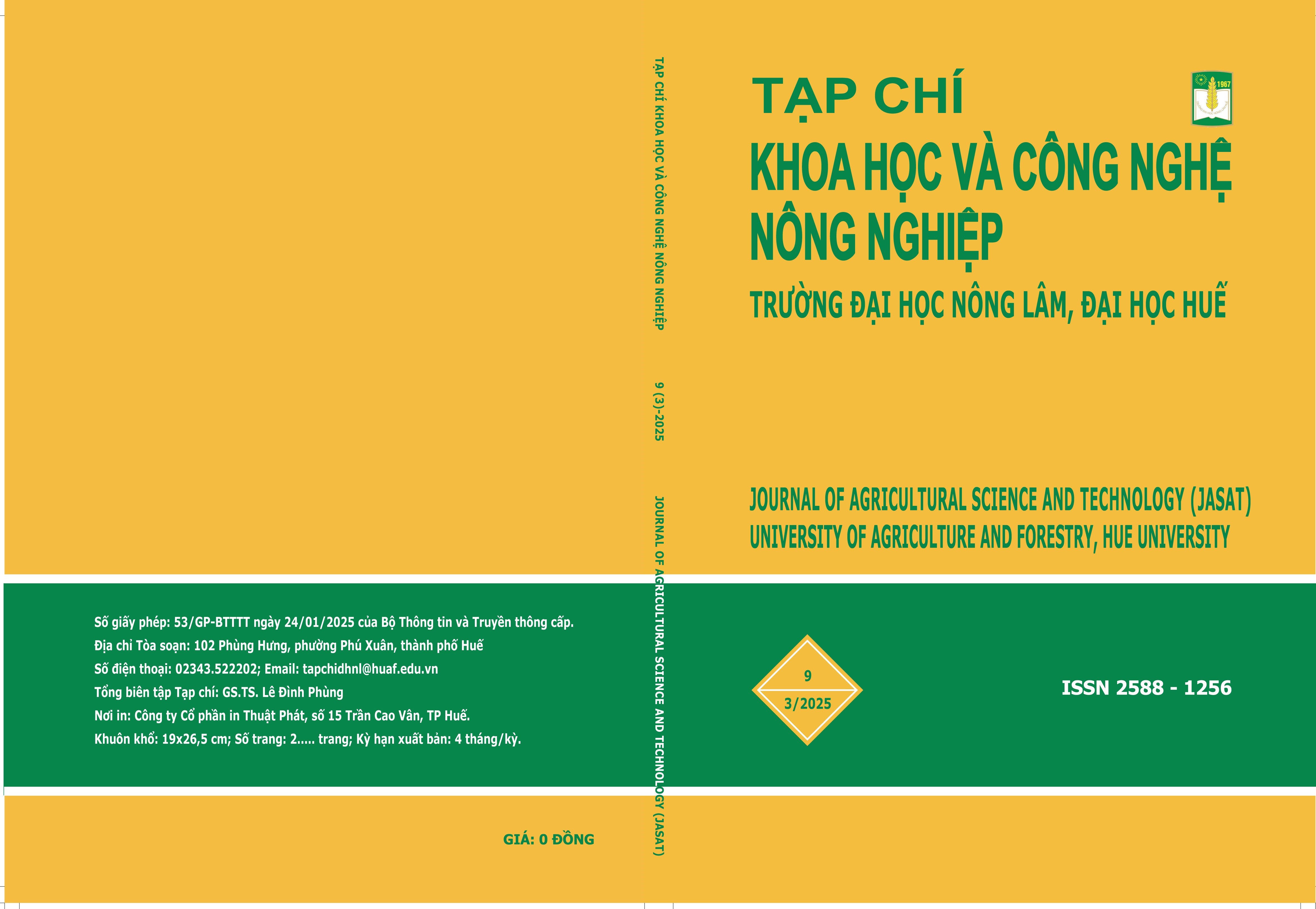##plugins.themes.huaf_theme.article.main##
Abstract
The study was conducted to determine the concentration of carbon nanoparticle solution on the growth and development of lettuce plants. The experiment consisted of 8 treatments arranged in a completely randomized block with three replications, each replication consisting of 10 pots. The formulas included no fertilizer and nano carbon solution, only manure and manure combined with nano carbon solution with different concentrations (10 - 60 ppm). Experimental results: Adding nano carbon solution with a concentration of 60 ppm showed the most optimal effect on the growth, development and yield of lettuce compared to other formulas. In particular, the time from planting to harvest (31 days), height (18.97 cm); number of leaves (18.63 leaves); canopy diameter (19.44 cm); leaf length (14.60 cm); leaf width (10.99 cm); biological productivity (138.93 g/pot), economic productivity (105.90 g/pot) were higher than other treatments. Pests do not significantly affect potted lettuce. Among the observed pests and diseases, Spodoptera litura, Diabrotica spp., damping-off, soft rot, root swelling disease, and snails exhibited low incidence rates, ranging from less than 5%. Moreover, the nano carbon solution also positively affects the dry matter and quality of lettuce (organic acid and vitamin C content).
##plugins.themes.huaf_theme.article.details##
References
Nguyễn Văn Liêm, Hà Minh Thanh, Lê Mai Nhất và Trịnh Xuân Hoạt. (2023). Phương pháp nghiên cứu Bảo vệ thực vật, tập IV, Phương pháp điều tra, chẩn đoán giám định một số loài sinh vật gây hại quan trọng trên cây trồng và nấm ăn ở Việt Nam. Nhà xuất bản Nông nghiệp.
Al-Mahmnur, A., Byung-Yong, P., Zafar, K.G., Mira, P., Hak-Yong, K. (2015). Synthesis of carbon quantum dots from cabbage with down- and up-conversion photoluminescence properties: excellent imaging agent for biomedical applications. Green Chemistry, 17, 3791-3797. DOI: 10.1039/C5GC00686D.
Camejo, D., Frutos, A., Mestre, T.C., Del, C.P.M., Rivero, R.M., Martínez, V. (2020). Artificial light impacts the physical and nutritional quality of lettuce plants. Horticulture, Environment, and Biotechnology, 61, 69-82. DOI: 10.1007/s13580-019-00191-z.
Chu, R., Xu, X., Lu, Z., Ma, Y., Cheng, H., Zhu, S., Bakker, F.T., Schranz, M.E., Wei, Z. (2022). Plastome-based phylogeny and biogeography of Lactuca L. (Asteraceae) support revised lettuce gene pool categories. Frontiers in Plant Science, 13, 1-18. DOI: 10.3389/fpls.2022.978417.
FAOSTAT. (2025). Food and agriculture organization of the United Nations, USA.
Jing, H., Wenyi, J., Xinyi, W., Haiyun, Z., Yin, W.J.L., Yu, Y., Shu, T., Xilong, W. (2022). Carbon dots can strongly promote photosynthesis in lettuce (Lactuca sativa L.), Environmental Science: Nano, 9, 1530-1540. DOI:10.1039/D1EN00948F.
Jaya, N., Xiaoping, X., Gabriel, M.L., Wiqar, A., Jorge, P., Swadeshmukul, S., Alan, L. W., Andy, O., Peter, J. S., Zhenli, H. (2023). Carbon nanomaterials are a superior soil amendment for sandy soils than biochar based on impacts on lettuce growth, physiology and soil biochemical quality. NanoImpact, 31.
Li, H., Huang, J., Song, Y., Zhang, M., Wang, H., Lu, F., Huang, H., Liu, Y., Dai, X., Gu, Z., Yang, Z., Zhou, R., & Kang, Z. (2018). Degradable carbon dots with broad-spectrum antibacterial activity. ACS Applied Materials & Interfaces, 10(32), 26936-26946. DOI:10.1021/acsami.8b08832.
Monika, C., Priyamvada, S., Gajendra, P., SinghBrijesh, R. (2024). Structural features of carbon dots and their agricultural potential. ACS Omega 2024, 9(4), 4166–4185. DOI: 10.1021/acsomega.3c04638.
Nepal, J., Xin, X., Wright, A. L., Maltais-Landry, G., Stoffella, P. J., Ahmad, W., & He, Z. L. (2022). Water-dispersible carbon nanomaterials improve lettuce (Lactuca sativa) growth and enhance soil biochemical quality at low to medium application rates. Plant and Soil, 485, 573–588. DOI: 10.1007/s11104-022-05852-0.
Thomas, N.J.I.E., Raji, A., Mathur, G.S., Jae-Jin, S., Yong, R.L. (2016). Microwave assisted green synthesis of fluorescent N-doped carbon dots: Cytotoxicity and bio-imaging applications. Journal of Photochemistry and Photobiology B: Biology, 161, 154-161. DOI: 10.1016/j.jphotobiol.2016.05.017.
Shen, J., Shang, S., Chen, X., Wang, D., Cai, Y. (2017). Facile synthesis of fluorescence carbon dots from sweet potato for Fe (3+) sensing and cell imaging. Materials Science & Engineering C,76, 856-864. DOI: 10.1021/10.1016/j.msec.2017.03.178.
Yadong, L., Xiaokai, X., Ying, W., Jianle, Z., Xuejie, Z., Haoran, Z., Bingfu, L., Chaofan, H., Yingliang, L. (2020). A review on the effects of carbon dots in plant systems. Materials Chemistry Frontiers, 4, 437-448. DOI: 10.1039/C9QM00614A.
Yinjian, Z., Gancheng, X., Xuejie, Z., Zhijie, C., Yijin, C., Wen, Y., Hechou, L., Junyang, S., Ruimin, L., Yingliang, L., Bingfu, L. (2017). Bioimaging application and growth-promoting behavior of carbondots from pollen on hydroponically cultivated rome lettuce. ACS Omega, 2 (7), 3958−3965. DOI: 10.1021/acsomega.7b0065.
Zaytseva, O., & Neumann, G. (2016). Carbon nanomaterials: Production, impact on plant development, agricultural and environmental applications. Chemical and Biological Technologies in Agriculture, 3(1), 1-17. DOI: 10.1186/s40538-016-0070-8.


